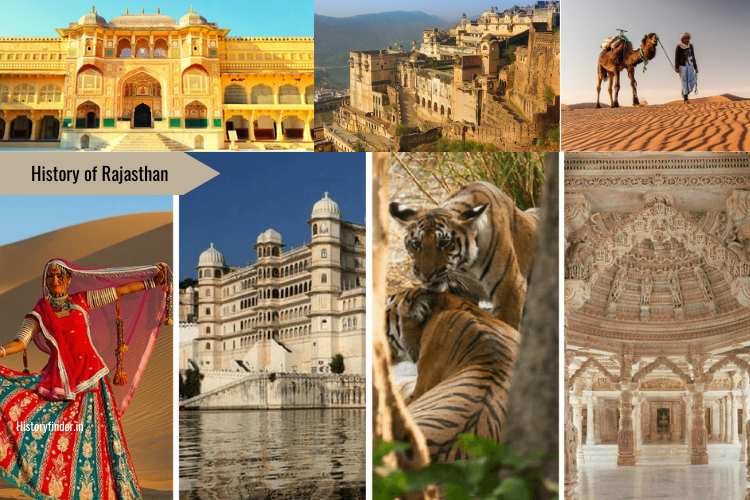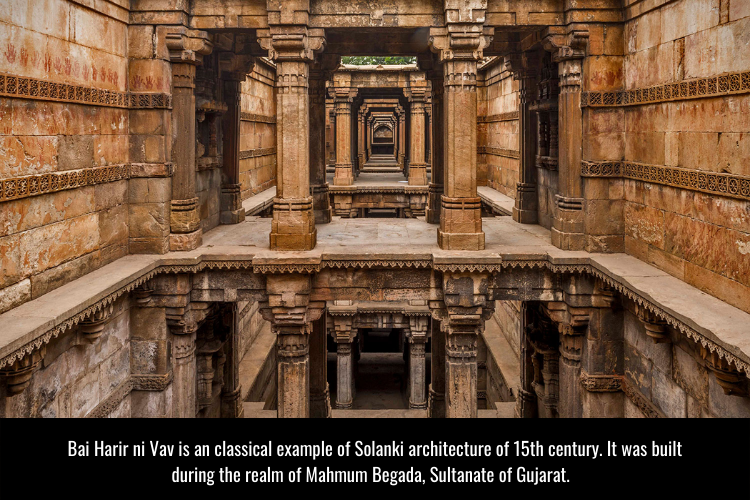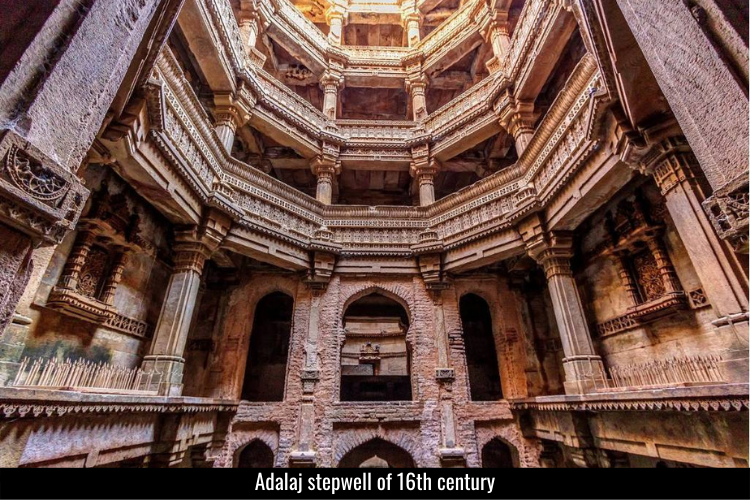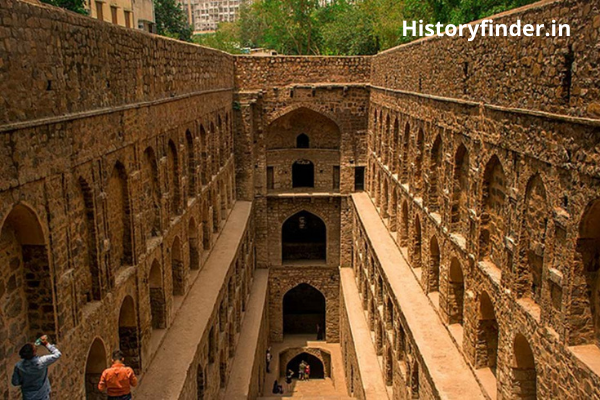Rajasthan is a state in north western region of India with fascinating history. The state is famous for its vibrant festivals, majestic forts, stunning palaces, and rich cultural heritage. Rajasthan before independence or Rajputana had a much larger territory, including Sindh and Punjab provinces of present Pakisthan, along with the present Indian state of Rajasthan. British Rajputana was divided into about 36 Rajput Kingdoms. History of Rajput Kings are even more interesting, especially for their matchless bravery, patriotism and royalty. In short, history of Rajasthan represents some fascinating history of Rajput warriors to protect their kingdoms from all external and internal political powers.
The ancient history of Rajasthan dates back to the Indus Valley Civilization, the oldest human civilization in India. Archaeological excavations had revealed the few of oldest Harappan settlements in Rajasthan which dates back to around 3000 BCE. However, oldest human settlements in Rajasthan is noticeable from Paleolithic or stone age that dates back to 400,000 BCE or even before. The culture of Rajasthan had been influenced by several migrations in different phases, including the Aryans, Persians, Greeks, and Scythians.
The word Rajasthan means the land of kings, arrived from the glorious period of Rajput rule. The medieval and modern history of Rajasthan is theerfore the most interesting from the rest. Rajput Kings had been famous for their rivalry with Delhi Sultanate and the Mughal Empire. However, the Delhi Sultanate and Mughal Empire had exerted their dominance over Rajasthan in different times. Later, many Rajput kings accepted Mughal sovereignty. Those Rajput-Mughal relationships certainly induced a fusion of Persian, Islamic cultures into Rajputana cultures.
During British colonial rule, Rajasthan became a princely state under the British Raj. The princely rulers of Rajasthan had a unique relationship with the British, often adopting modernization while preserving their cultural traditions. After India gained independence in 1947, Rajasthan united with other princely states to form the present-day Indian state of Rajasthan.
Stone Age Cultures in Rajasthan (1000,000-10,000 BCE)
Rajasthan has a long unique history which certainly began with the pre-historic human settlements. Hundreds stone age settlements of Homo Erectus or proto-humans are bearing its unarguable testimony. Several pre-historic cultures had settled in the region who left their traces of living. Archaeological excavations unearthed many of them, especially their hunting and fishing tools, potteries, paintings and many other goods. Traces of houses and villages were also found in late stone age cultures in Rajasthan. Stone Age findings, therefore, had a significant contribution in shaping up the history of Rajasthan.
Stone Age is ideally divided into three phases, namely, Paleolithic, Mesolithic and Neolithic Ages. Paleolithic Age refers to the Early Stone Age settlements, dating around 1,000,000-100,000 BCE. Central and southern regions of Rajasthan are highly rich in Paleolithic sites. Mesolithic Age however, refers to Mid Stone Age which dates between 100,000 and 40,000 BCE. However, the aging varies a lot from place to place. Neolithic or late stone age settlements, in contrary, are very rare in Rajasthan. Archaeologists are still working on it.
Didwana Jayal Culture (400,000 BCE)
Archaeological sites of Didwana in Nagaur district are undoubtedly a significant addition to the early stone age history of Rajasthan. Traces of Homo Erectus was discovered from several excavations between Didwana and Jayal. The Carbon-14 dating of Didwana-Jayal artefacts revealed that the culture existed around 400,000 BCE, during middle Paleolithic Age. Paleolithic stone tools like handaxe, cleaver etc were among the major artefacts.
Bagor Culture (5,000 BCE)
Bagor in Bhilwara district was the largest discovery of Mesolithic settlement in Rajasthan. Archaeologists have confirmed that the oldest Mesolithic culture of Bagor dates back to 5,000 BCE only. Bagor excavations revealed five human skeletons from a Mesolithic graveyard. Further, Mesolithic tools like spearheads, arrowheads and truncated blades unearthed from the archaeological site.

Basins of Pachpadra, and Sojat and Tilwara regions in Rajasthan are also intense in Mesolithic sites. The mid stone age culture involved fishing, hunting, farming, painting and pottery. Tools in Mesolithic Age became much smaller in size and duly sharpened. Signs of animal domestication also very prominent. Rock paintings in red and white, especially made from plant nubs was the most significant development of Mesolithic cultures.
Metal Ages in Rajasthan (post 5,000 BCE)
Chalcolithic or the Copper-Stone Age is the earliest phase of Metal Age. The span of Chalcolithic period in Rajasthan was however, very short, only a few thousand years. The oldest Chalcolithic site in Rajasthan dates back to 5,000 BCE.
Ganeshwar-Jodhpura Culture (3,800-2,000 BCE)
The Ganeshwar-Jodhpura Culture is the oldest metal age settlement in Rajasthan. About 80 Chalcolithic pre-Harappan sites had been identified present Neem ka Thana district of eastern Rajasthan. The Ganeshwar-Jodhpura culture consisted of three cultural phases. The oldest cultural phase dates back to around 3,800 BCE. Uses of chert tools for fishing and hunting had been spotted during this period. But uses of copper did not begin. Next cultural phase began around 2,800 BCE which used of copper bangles, chisels, fishing hooks. Fired clay pottery and copper hunting tools like arrowheads and spearheads were among the developments. The newest phase dates back to 2,000 BCE when several uses of copper objects had been noticed. Art of pottery also had adopted a lot of variety.
Ahar-Banas Culture (3,000-1,500 BCE)
The Ahar-Banas Culture of south-eastern Rajasthan was the most prominent Chalcolithic culture in the state. More than 90 Chalcolithic sites were discovered in the Ahar and Banas river basins. The Chalcolithic culture existed around 3,000-1,500 BCE, prominently in ceantral and southern Rajasthan. It was spread across a large area covering the districts of Udaipur, Chittorgarg, Dungarpur, Banswara, Ajmer, Tonk and Bhilwara.
Ahar -Banas culture had major influence of its geographic location, especially the copper ores of Aravalli range. Prominent uses of copper spearheads, arrowheads and axes bearing the impression of Chalcolithic era in the region. The primitive stone tools also had been modernized. Availability of advanced tools played a significant role in agricultural developments. Many traces of wheat and barley farming observed in several places. A large number of seal impressions had been discovered from the archaeological site
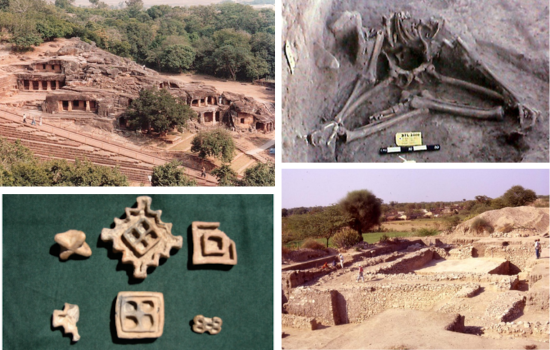
Balathal, the archaeological site in Udaipur is an unique example of Ahar-Banas culture, the early metal age history of Rajasthan. Balathal exploration revealed remains of domesticated animals, grains, potteries, copper objects etc. and square structured houses made of mud bricks. Which means the culture already had adpoted practices like animal domestication, agriculture, pottery etc. Balathal excavations further unearthed a 37 years old human skeleton, dating back to 2,500-2,000 BCE. The male adult was suffering from leprosy, makes it among the earliest evidences of the desease in south Asia. Several Harappan objects also discovered from the site. Archaeologists thus believe that the culture was contemporary to the Harappan Civilization and probably began the practices of exchanges with them.
Sindhu-Saraswati or Indus Valley Civilization (3,300-1,300 BCE)
Sindhu-Saraswati or the Indus Valley Civilization is known as one of the three oldest civilizations in Asia, along with Ancient Egypt and Mesopotamia. Located between the vast regions between Sindhu and Saraswati river banks, it is also notable as oldest civilization in the Indian subcontinents. Traces of Indus Valley Civilization had therefore discovered in several parts of Rajasthan, enriching its history. The civilization existed between 3,300-1,300 BCE, however, flourished around 2,500-1,900 BCE.
Kalibangan Civilization (3,000 BCE)
The archaeological site of Kalibangan, located in the Hanumangarh district, appears among the most significant Metal age sites in Rajasthan. Excavations here have revealed the remains of a lost city, that flourished around 3,000 BCE. It certainly makes Kalibangan the oldest but lost city of Rajasthan. The Archaeological Survey of India (ASI) had declared the site as the ‘Major provincial capital of Indus Valley Civilization’ in 2003.
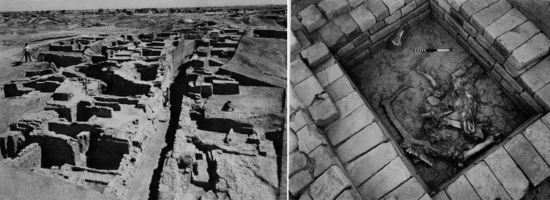
The agricultural practices undeniably improved during the period. The unearthed artefacts certainly articulates the Kalibangan culture including very distinguished agricultural practices. Traces of ploughing fields seemed to be the oldest as far as the world’s historical records are concerned. Kalibangan therefore is notable for its world’s earliest attested ploughed field.
Rajasthan in Vedic Age (1,500-500 BCE)
Around 1,500 BCE, the Indus Valley Civilization started declining. During Rig Vedic or early Vedic period (1,500-1,000 BCE), the Indo-Aryans, started settling in north-western Indian region. According to Rig Veda itself, early Vedic settlements took place within the Saptasindhu (land of seven rivers). Sapta sindhu refers the region from the river Sindhu in the west up to the river Saraswati to the east. Other five rivers namely Jhelum, Chenab, Ravi, Beas and Sutlej belong the region of Punjab. The history of Rajasthan, therefore, had a very high influence of early vedic settlements.
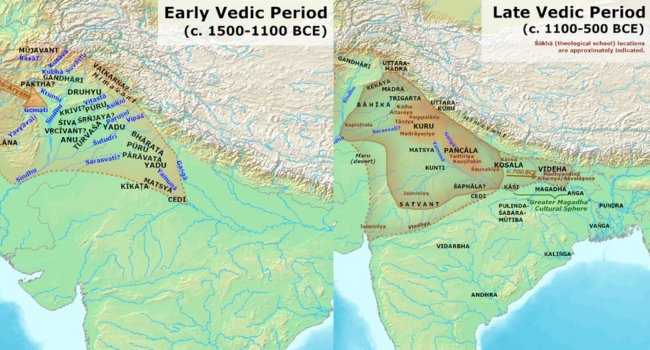
Rajasthani culture undeniably adopted several aspects of Hindusim from the Vedas. Glimpses of Vedic cultures reflect in Rajasthani languages, cultures, rituals, art, music and literatures as well. All of the 19 different Rajasthani languages had been the descendants of Sanskrit. Rajasthani festivals and rituals are also bearing the imprint of Vedic culture. Traditional festivals such as Diwali, Holi, and Teej, have their roots in Vedic rituals and mythologies.
Vedic art and music also had a lot of contribution in Rajasthan’s cultural landscape. Scenes of Hindu mythology and tales visible in Rajasthani miniature paintings are mostly Vedic impressions. Many ocre colored potteries of Vedic age had been discovered in the state. Most of them are even older than Vedic potteries unearthed from Ganges doab region. It certainly indicates Vedic civilizations in Rajasthan belong to the early or Rig Vedic period. The traditional folks like Phad, Pichwai and the devotional Bhajans, often reflect Vedic hymns.
Vedic Age Tribes
Puru Kingdom was actually a Rigvedic tribe that ruled in the Sapta Sindhu region during 1,700-1,400 BCE. Mandala 4 of Rigveda had the mentions about the Puru chieftain who moved into the land of Sapta Sindhu from the west of Sindhu river.
The Matsyas were among the other Indo-Aryan tribes who had a presence during the Rigvedic period. They had a prominent pesence between the rivers of Saraswati and Chambal.
Bharatas were the most prominent tribes during the Rig Veda age, and probably one of the factions of the Purus. They defeated several Indo-Aryan tribes in the Sapta Sindhu region to establish a large settlement.
Battle of Ten Kings: Establishment of Kuru Kingdom
The Mandala 7 of Rigveda mentions about the famous battle between the Bharatas and the confederation of other nine tribes. Bharata King Sudas and his commander Vashishtha were able to neutralize the strong opposition army led by the Purus. The nine tribes’ alliance consisted of:
- Purus
- Alina
- Anu
- Bhrigus
- Bhalanas
- Dasa
- Druhyus
- Matsya
- Panis
The battle of ten kings eventually resulted a decisive victory of Bharatas and establishment of Kuru Kingdom. According to Rigveda, the Purus’ allied forces had suffered a casualty of 6,666 soldiers in the battle. The Bharatas, on the other side, had a much smaller army but yet suffered much lesser casualty. Kuru Kingdom expanded ober a very large territory, to became the first recorded state in the Indian subcontinents.
Ancient Period (500 BCE-400 CE)
The early ancient period, especially the Pre-Mauryan era of Rajasthan lacks enough historical evidence. Mahabharata, the Hindu scripture and epic of India, is one of the golden sources of ancient history of India. Adi Parva of the great epic provides an overview of post vedic communities, kingdoms and their cultures in the region.
Existence of Mahabharata mentioned kingdoms
Sabha and Bhishma Parva of Mahabharata mentions about this province, which developed near the river Saraswati. Abhiras had supported Duryodhana in the epic war of Mahabharata. However, present Abhira territory lies within northern Gujarat and southern Rajasthan. The Abhiras later established as a large kingdom across Nashik, Khandesh and Vidarbha.
Salva dynasty ruled in the northern Rajasthan, very close to the Madra Kingdom. Satyavan was the famous Salva ruler in exile who married Madra princess Savitri. The legendary tale of Savitri and Satyavan is extremely famous in Hindu culture. Savitri persuaded Yama, the god of death to restore her husband’s life. Hindu married women, thereafter performs ‘Savitri Brata’, for the well being and long life of their husbands.
The Mahabharata further mentions about the Matsyas and the Pachals among the other tribes who ruled in nearby region during ancient era.
Mauryan Impressions (329-185 BCE) in Rajasthan
Mauryan era was probably the most prominent period in the ancient history of Rajasthan. Minor rock edicts of Ashoka found at Bairath hills, marks the Mauryan rule in eastern Rajasthan. The Buddhist temple of Bairath is also recognized as the oldest free standing temple in India. One of the 3rd century BCE Edicts mentions the king Ashoka as ‘Priyadarshi’. The Asiatic Society Museum of Kolkata now preserves these edicts.
Rise of Indo-Greek Kingdoms
The Greek warrior Alexander the great defeated the Purus King Porus in the battle of Hydaspes in 326 BCE. However, Alexander reinstalled him as his Satrap (governor) for the region he was already ruling (between the rivers Jhelum and Chenab). The victory coin of Alexander depicts his vicotry of Porus. Alexander established several small settlements in the Punjab region. But he didn’t progressed further east and avoided battles with great Mauryan empire. Later those greek satraps formed small kingdoms of their own.

Several Indo-Greek dynasties had emerged in power in post Mauryan era, especially in Punjab, western and north-eastern Rajasthan. About 20 Indo-Greek kings had ruled in these provinces of Rajasthan and Punjab. Yaudheya and Arjunayana kingdoms were the greatest rivals of them. However, during the early 1st century CE, the Indo-Greek dynasties had almost disappeared from Rajasthan and Punjab.
Emergence of Western Satraps or Kshatrapas (35-415 CE)
The Indo-scythian rulers controlled a large territory of north-western India for about 400 years. It included the provinces of Sindh, Rajasthan, Gujarat, Maharashtra and Madhya Pradesh. According to the available historical evidences, Abhiraka was the first known Kshatrapa dynasty ruler, ruled around 30 CE. However, his rare coins mostly discovered in northen Pakistan and Afghanistan. Bhumka, son of Abhiraka, succeeded his father and ruled until 119 CE. Nahapana, who further succeeded his father Bhumka, was one of the greatest Western Satrap kings.
Western Satrap kings were patrons of Buddhism. The 6 CE Taxila copper inscription had a mention of dedication of Buddha’s relics by the Indo-Scythian ruler Patika Kusulaka, son of Liaka Kusulaka, the Satrap of Chukhsa. Bhumka’s coins bear Buddhist symbols. The Nahapana inscription at the Great Chaitya of Karla Caves in Maharashtra, also shows his support of Buddhism.
The conquest of Gautamiputra Satakarni of Satavahana dynasty in 2nd century CE, began the decline of Western Satraps. It somehow survived for another century until Gupta king Samudragupta invaded in middle of 4th century CE. Finally, Chandragupta II completely demolished the Western Kshatrapa rule from Rajasthan and other regions of Indian subcontinents.
Western Kshatrapa rule in India had overseen the transformation of languages which reflected from the different scripts discovered from their times. Nothern territories used Kharoshthi whereas use of Brahmi and Greek scripts were noticeable in Satrap coins. Occassional uses of Pakrit and Sanskrit are also observed in various Kshatrapa coins.
Classical Age in Rajasthan
Gupta period is usually renowned as the Classical Age of India. The Gupta Empire, during its peak time, had expanded through entire western, northern and eastern Indian subcontinents. It flourished in all segments including economy, politics, science, literature, art, architecture and culture. The Gupta period is therefore recognized as the ‘Golden Age’ of India. Rajasthan also being the part of the Gupta empire had progressed all these dimentions.
Gupta Acquisition
The Gupta Age in Rajasthan began with Samudragupta’s campaign. He had defeated Satrap ruler Rudrasimha II in 351 CE and captured some territories of south eastern Rajasthan. Several Samudragupta coins were discovered from the said region of Rajasthan. Later Chandragupta II, dethroned the last Saptrap ruler Rudrasimha III in 415 CE. It establisehd the Gupta dominance in entire Rajasthan.

Although, the Gupta kings ruled from Ujjain, and hence mostly stayed away from the region. But, the footprints of Gupta legacy was spread all across the state. Rajasthan definitely progressed in art, architecture, science and literature during the ‘Golden Age’ of India. The region being the only connect to west and central Asia, also flourished in economy as one of the major trading hubs of the Guptas.
Rise of Rajput Dynaties
Medieval age in India began with the decline of the Gupta empire and different dynasties emerged in power. In Rajasthan, several dynasties rose in power 6th and 11th century. Pratihars (or, the Gurjar Pratihars) of Kannauj were the most prominent dynasty among them. In addition, Rajput dynasties like Guhilas of Mewar, Pratihars of Mandore, Bhatis of Jaisalmer, Chauhans of Ajmer also became powerful.
Rise of Pratiharas (550-1036 CE)
The Pratiharas had been the most significant Rajput dynasty of medieval Rajasthan. Theye were also known as Gurjara Pratiharas. But the Pratihar kings never caleed themselves Gurjars. However, their neighboring states sometimes, called them Gurjara-Pratiharas, from where the name arrived. Harichandra, the first Gurjara-Pratihara king, established Pratihar Kingdom at Mandavyapura (former Mandore). Until 9th century, the Pratihara dynasty of Mandavyapura ruled in the north-western India.

Another Pratihara dynasty emerged during early 8th century, in Kannauj area. Nagabhata Pratihara I, who established Gurjara Pratihara dynasty at Kannauj, were probably feudal ruler of the region under Chavda kings of Gujarat. He further conquered areas up to Sindh at the west, Malwa to the south and Gwalior to the east. Nagabhata I also neutralized the Umayyad campaigns in India at the Battle of Rajasthan in 738 CE.
The Pratihara kings successfully stopped several Arab invations, for three long centuries, the most significant feature of Pratihar rule in Rajasthan. Mihira Bhoja and his son, Mahendrapala, took the Pratihar empire at its peak. By late 9th century, the empire expanded up to the Himalayas in the north, Narmada river to the south and easten India up to Bengal.
Pratihar kings were notable for creating stunning architetures and artworks across the country. Mahavira Jain Temple of Osian in Jodhpur district is a classic example of Pratihara architecture. It is also the oldest surviving Jain temple of western India and Rajasthan. Badoli temples of Rawatbhata in Chiitorgarh is another notable Pratihara architecture. Ruined city of Osian near Jodhpur also represents Pratihara settlements during 8-10th century. Outside Rajasthan, the famous Khajuraho temple architecture is another Pratihara architetural marvel.
Guhila Dynasty of Mewar
The Guhila dynasties were among the oldest Rajput dynasties. They ruled during 6th century from Medapata, the modern Mewar region in Rajasthan. Bappa Rawal (728-763 CE) played a significant role in increasing the Guhila’s political status. Some chronicles consider him as the founder of Guhila Rajput dynasty. However, Bappa Rawal was notable Guhila king (Rawal) for his exceptional military achievements. He prevented the Arab invasion of early 8th century.
His descendants continued to rule from Mewar, with the title of Rawal until Rawal Ratansimha defeated by Delhi Sultanate’s Siege of Chittorgarh in 1303.
Sisodiya Dynasty of Mewar
Rana Rahapa had set up his capital at Shisoda village in present Rajsamanad district of Rajasthan in 1160. Therefore, his discendants are known as Sisodiyas. However, after the Siege of Chittorgarh of 1303, the Guhilas lost control of Chittorgarh. Rana Hammir Singh, reclaimed the control in 1326. He therefore, sometimes called the founder of Sisodiya Rajputs at Chittor.
Sisodiya Rajput kings ruled Mewar until 1948, until they joined the dominion of India. Rana Kumbha (1433–1468 CE) was notable Sisodiya Rajput king, especially for his exceptional military skills. He built 32 forts in Mewar including the Kumbhalgarh Fort and strengthened the defence of Mewar. The Rajput kingdom of Mewar prospered to its peak during the rule of Rana Sanga (1508-1528). Maharana Pratap (1572–97) was probably the greatest Rajput ruler in the history of Rajasthan. His lifelong rivalry with Mughal emperor Akbar was the greatest feature of his life history.
Chauhan Dynasty of Ajmer
The Chauhan dynasty rose in power during 10th century. However, the dynasty is traceable to 6th century, as the vassals of the Pratihara kings. Initially they were ruling from Shakambhari or former Sambhar Lake Town. Chauhan king Maharajadhiraj Ajayaraja II moved his capital from Shakambhari to Ajayameru, modern day city of Ajmer.
Chauhan rajput kings of Sambhar and Ajmer, was notable for extreme bravery and royalty. Ajayraja II and his discendant, Arnoraja, had terminated several Turkic invasions in different periods. King Vigraharaja IV was notable for expanding his kingdom up to Delhi, capturing from the Tomaras. Prithviraja III, famous as Prithviraj Chauhan, notable for defeating the Chandela kings. He also defeated Ghurid Sultan Muhammad Ghor in the first battle of Tarain in 1191. However, the next year, Mohammad Ghor defeated and killed Prithviraj Chauhan in the second battle of Tarain.
Chauhan kings had made several constructions, especially Hindu temples. However, Ghurid invaders had destroyed many of them, after they defeated Prithviraj Chauhan. But many of them still remaining as a cultural heritage of Chauhan Rajput kings in the history of Rajasthan. Raja Simharaja constructed a large Shiva temple at Pushkar, near Ajmer. King Someshvara also built several hindu temples at Ajmer. Apart from these, Ana Sagar lake was built by Chauhan king Arnoraja.
Bhati Dynasty of Jaislamer
Bhati Rajput dynasty emerged during 12th century in Jaisalmer region of Rajasthan. Rawal Jaisal Singh of Lodarva, founded Jaisalmer, the Golden City in 1156. The successors of Rawal Jaisal continued to rule Jaisalmer as the heriditary owners until the independence of India. Jaisalmer city now forms the integral part of Jaisalmer district, the region where the Bhati Rajput dynasty once ruled.
Rawal Jaisal also constructed Jaisalmer Fort, the Golden Fortress, on the ancient Silk Road. Jaislamer once prospered by collecting taxes from the passing traders. However, after independence and partition of India, the route was permanently closed. As a result, Jaisalmer also lost all its importance.
Jaisalmer Fort had been besieged multiple times in its history. Alaudding Khilji of Delhi Sultanate seiged the fort in 1299. He eventually captured the fort after long eight years of seige. The defeat resulted a massive Jauhar performed by Rajput womens of the fort, to avoid being defiled by their enemies. Jaisalmer fort was further invaded and sieged several times which caused the Bhati Kings lost control over the fort and the region. However, they regained their control within a very short period, every time. Late Bhati rulers accepted suzerainty of the Mughal and British empires to remain in power.
In 1950, Jaislamer finally merged with the Union of Rajasthan. However, Bhati Rajputs remained the titular kings of Jaisalmer.
Kachwaha Dynasty of Dausa and Amer
Several traces of Kachwaha Rajput dynasty are found in the medieval and modern history of Rajasthan. Kachawaha dynasty emerged in power during 10th century. Major seats of the Kachawahas actually belonged to Kannauj, Gwalior etc. But after Pratihara decline, they emerged in Rajasthan, especially in Dausa region. The Kachwaha palace of Dausa and Chand Baori are some incredible Kachwaha architectures. Later, the Kachwaha king Beejal Dev shifted his capital to Amber in 1146.
Raja Man Singh built the famous Amer or Amber Fort in 1592. Raja Sawai Jai Saigh founded the ‘Pink City’ of Jaipur in 1727. he also commissioned the City Palace of Jaipur in the same year and moved to Jaipur. The Kachwaha kings thereafter also known as the Kachwaha kings of Jaipur.
The kingdom of Amber and Jaipur remained the largest kingdom of Kachwaha dynasty. They ruled at Jaipur until it merged with Union of India in 1949 along with other Rajput states. Jaipur eventually became the capital of the Indian state of Rajasthan. Man Singh II, the last Kachwaha king became the Rajapramukh (the Governor) of the state.
Rathore Dynasty of Marwar
Rathore dynasty emerged in Marwar region during mid 12th century. Some historians urge that Rathores were the descendants of Rashtrakutas. However, the strongest theory states that the Rathores were the descendants of Gahadvala dynasty of Kannauj. Gahadvala prince Asthan had settled in Pali region of Rajasthan after Mohammad Ghor captured Kannauj in 1194.
Rao Chunda (1384-1428), a descendant of King Astha, married a Pratihara princess. He got the fortified city of Mandore in dowry along with a thousand villages. It established the Rathores strongly in Marwar. Rana Kumbha of Mewar conquered Marwar in 1438. A significant part of Marwar also went under Delhi Sultanate. As a aresult, Rathore rule over the Kingdom of Marwar came to a halt.
Rao Jodha, grandson of Rao Chunda, regained the lost territories from the Sisodiyas of Mewar and Delhi Sultanate around 1453. He therafter built the Mehrangarh Fort and founded the city of Jodhpur in 1459, after his name. The city of Jodhpur presently known as the ‘Sun City’ or ‘Blue City’ of India. Rao Bika, son of Rao Jodha constructed Junagarh Fort in 1478. He also founded a new city around the fort in 1488, named Bikaner (ner means ‘city’ in Rajasthani language) after his name.
Rahtore dynasty continued to rule Marwar kingdom until 1949. Maharaja Hanwant Singh, the last Rathore king of Jodhpur, joined the Republic of India. As a result, the state of Marwar became the part of Indian state of Rajasthan.
Mughal Influence in Rajasthan
Rajputana rose to its peak prosperity and power during the reign of Rana Sanga of Mewar (1508-1528). During his rule, the Rajpur confederacy became the strongest power in northern India. Rana Sanga also tried to eliminate Babur from Delhi and Agra and reestablish Hindu rule in northern India. But the Rajput military alliance lead by Rana Sanga was heavily defeated by Babur’s modern artillery and muskets firing at the Battle of Khanwa in 1527. Some historians therfore belive that the Battle of Khanwa had more significance than the First Battle of Panipat for Mughal expansion in India.
Mughal emperor Akbar tactfully used both his diplomacy and military campaigns to expand his territory in Rajasthan. He led the seige of Chittor in 1568 to capture Mewar from the Sisodiya Rajputs. Akbar subsequently led the siege of Ranthambore to defeat Chauhan king Surjan Hada.
Mughal emperor Akbar also began his marriage policy to earn the faith of the Rajput kings. He himself married Jodhabai, daughter of Raja Bharmal and the princess of Amer. Akbar also got several Mughal princes to marry Rajpur princesses to continue the trend. As a aresult, several Rajput kingdom accepted Mughal suzerainty. The Kachawahas of Amer was one of them. However, many Rajput states like the Sisodiyas of Mewar and the Rathores of Marwar didn;t accept the Mughal supremacy. The rivalry of Maharana Pratap and Mughal emperor Akbar is the greatest interesting chapter in history of Rajasthan and Mughal Empire.
The Rajput policy of Akbar was duly followed by his descendants, Jahangir and Shah Jahan. They honored several Rajput kings with high ranks in Mughal court anf military forces. But the Rajput Mughal relationship deteriorated during Aurangzeb’s regime. He followed orthodox Islamic policy with the rajputs, withdrawing few of their privileges. This led to Mughal Rajput confrontation.
Maratha Intervention in Rajasthan (1720-1817)
Maratha Empire started expanding under leadership of Peshwa Bajirao I, during early 18th century. With the decline of Mughal Empire, the newly formed Maratha Empire had conducted few raids especially in the states of Kota, Bundi, Mewar and Marwar. Their primary objective was however, not to capture territories but just to collect revenues. But it led to a situation that the Rajput kings soon realized that weakening Mughal Empire won’t be able to protect them anymore from the Maratha invaders.
Several Rajput kings later began to invite the Marathas to resolve their succession disputes. They offered large amount of rewards against them. Bundi was the fisrt Rajput state to invite the Marathas to settle their domestic issues. Later, the states of Jaipur, Jodhpur and Mewar followed them. Marathas soon became a supreme power and started leving tributes and also plundering the territories. It led the Rajputs kings lost faith in the Marathas and started looking for a new auhtority. With rise of East India Company in early 19th century in northern India, Maratha intervention in Rajasthan eventually ended.
Establishment of Jat States
Jat chiefs of Delhi, Agra and Mathura regions started revolting against the Mughals during the late 18th century. Mughal emperor Aurangzeb, however, destroyed many of those rebels. However, few of the remaining Jat chieftains continued the revolt. Jat revolt began regions like Bharatpur and Dholpur in Rajasthan as well. Aurangzeb approached Kachwaha king Bishan Singh to support him in mitigating the Jats. It resulted Jat Rajput confrontment for the Zamindari rights had further complicated the issues. Jat unions at Bharatpur and Dholpur regions became stronger. They removed the Rajputs and formed independent Jat kingdoms.
Jat kingdom of Bharatpur
In 1685, Jat chief Raja Ram of Sinsini village consolidated the Jats and revolted against the Mughals. His succussor, Churaman, despite of being defeated by the Mughals, continued the unrest. During early 18th century, Mughal Empire started weakening as a result of their internal civil war. Churaman took the advantage and expelled the Rajputs from Bharatpur and established an independent Jat kingdom.
Maharaja Suraj Mal was the most remarkable king of Bharatpur Kingdom. Under his leadership, the Jat kingdom of Bharatpur expanded in eastern Rajasthan, southern Haryana, western Uttar Pradesh and Delhi. Capturing Delhi and Agra in 1761 was prehaps the greatest achievement of King Suraj Mal. He was also infamous for melting two silver doors of famous Taj Mahal of Agra. The Jat kings ruled over Agra Fort until 1774, before Mughal army defeated the Jats.
Maharaja Jaswant Singh (1853-93) accepted British suzerainty to maintain the state administration. The Jat princely state of Bharatpur finally joined the Republic of India in 1948 and became a district of Rajasthan state.
Jat Kingdom of Dholpur
Rana Kirat Singh Gohad founded the princely Jat Kingdom of Dholpur in 1806. Until 1775, Dholpur was the part of the Jat kingdom of Bharatpur. Later in 1805, it went under control of Gwalior Kingdom. The Jat Ranas eventually accepted to become British protector in 1806, when it was given status of a princely state. Same year Gohad also merged with Dholpur state. After 1818, it became a part of British Rajputana Princely state, later part of Rajputana Agency. The Jat Ranas ruled the state until it merged with the Republic of India in 1948.
British Influence in Rajasthan
Before arrival of the British, Rajput kingdoms were majorly disturbed by the irregular military invasions of the Marathas and Pindaris. Lord Wellesley and subsequently, Lord Hastings saw the opportunity to ally with the Rajput Kingdoms, against those invading powers. Hence, penetration of East India Company in Rajasthan’s princely states were rather easy.
Around 1817-18, the British Company had almost executed the treaties with all the princely states of Rajasthan. Later, British East India Company developed Rajputana Agency in 1832 head quartered at Ajmer. It consisted the territory of Ajmer-Mewara which was under direct British rule, surrounded by 19 princely states of Rajasthan. Rajputana Agency directly reported to the Governor General of British India. The head quarter was later shifted to at Mount Abu in 1845. In 1948, it became the part of Indian state of Rajasthan.
